Explore Mars
Mars is our nearest planetary neighbor. Like a distant unexplored land, it has been an object of curiosity for millennia. It was Tycho’s precise measurement of the orbit of Mars that enabled Kepler to devise the first of his laws in 1609, and Newton to recognize the universal nature of gravity in 1665. The possibility of life on this unknown red planet inspired H. G. Wells to write War of the Worlds, and Congress to authorize NASA’s continuing exploration of Mars.
Imaging with Telescopes
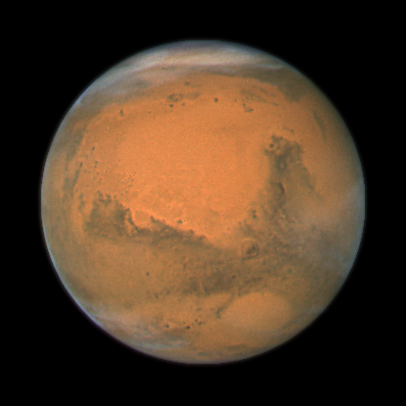
NASA's Hubble Space Telescope took this image when Mars was just 88 million kilometers (55 million miles) away from Earth in 2007. The image was assembled from a series of exposures taken during opposition that year. That's when Mars appears to rise at sunset, and the Earth is passing Mars at their point of closest approach.
Mars and Earth have a "close encounter" such as this about every 26 months, and the last one was in the spring of 2012. These periodic encounters are due to the differences in the two planets' orbits. Earth goes around the Sun twice as fast as Mars, lapping the Red Planet about every two years. Both planets have elliptical orbits, so their close encounters are not always at the same distance. In its close encounter with Earth in 2003, for example, Mars was 32 million kilometers closer than was is in this 2007 closest approach, resulting in a much larger image of Mars as viewed from Earth in 2003.
The two dominant dark swatches seen just south of the equator on this part of the planet are well observed regions that were originally labeled by early Mars observers. The large triangular shape to the right is Syrtis Major. The horizontal lane to the left is Sinus Meridani. One of NASA's Mars Exploration Rovers, named "Opportunity," landed at the western end of this region in January 2004. At the intersection of these two features is the prominent Huygens crater with a diameter of 270 miles (450 kilometers). South of Huygens is the Hellas impact basin, with a diameter of 1,100 miles (1,760 km) and a depth of nearly 5 miles (8 km). Hellas was formed billions of years ago when an asteroid collided into the Mars surface.
The planet appeared free of any dust storms at this time, however there are clouds visible in both the northern and southern polar cap regions. Compare that view from Hubble with this new one from an observatory in the French Alps.
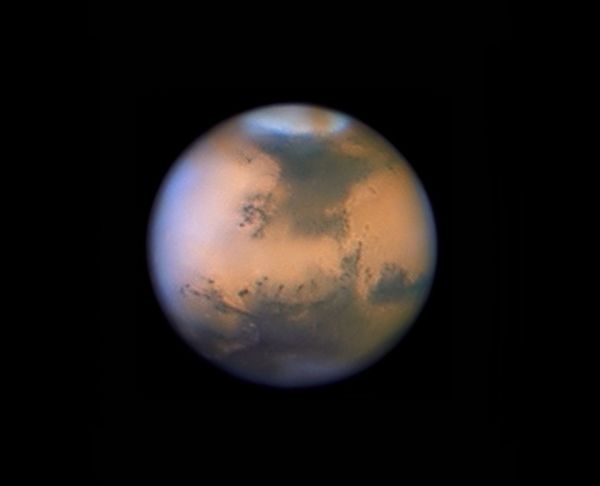
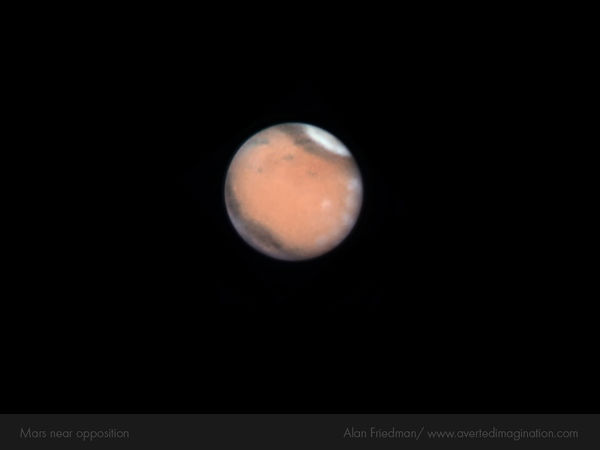
In this view taken close to the 2010 opposition it is spring in the northern hemisphere of Mars, and a dramatic dust storm cuts across the north polar cap extending from the dark region known as Mare Acidalium just below the cap. Here's another one, taken a few days before by an amateur astronomer with a small "10-inch", 0.25 meter, telescope.
You can see from these images that the views we have of Mars change quickly due to the rotation of the planet, its distance from us, and the quality of the telescope. Remarkably, even small telescopes such as this one may show fine detail, and they allow us to track the changes in Mars with its seasons. However, our best knowledge of the planet comes from the robotic spacecraft that have been sent to fly by it, orbit around it, and land on its surface. A fast simple way to explore Mars as seen by spacecraft is to use this link:
Take a few moments and see what you can find here. You might "right click" and " and select the option of opening in another window if your browser will allow it. If you have "Google Eearth" installed on your computer, you may use it for 3D interactivity with the most recent data.
There is a movie at this link that will show you how to use this software which we recommend strongly.
The Orbit of Mars
Mars follows an elliptical orbit around the Sun, completing it in one "period" of 1.88 Earth years. The size of an elliptical orbit is defined by its "semimajor" axis, half the distance across the long dimension of the ellipse. It is to an ellipse what a radius is to a circle. The semimajor axis "a" of Mars orbit is 1.52 times that of Earth, that is, 1.52 astronomical units (AU).
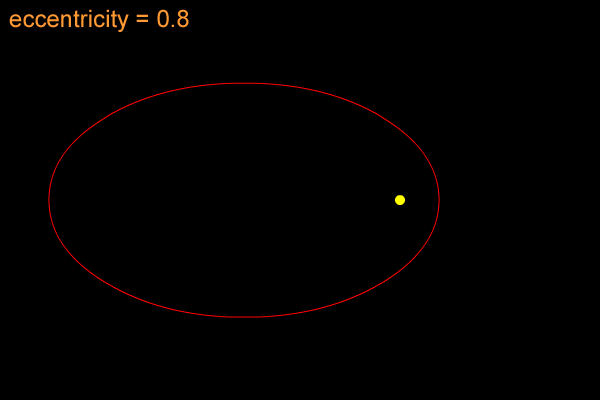
For an orbit of a planet, the Sun is at a "focus" of the ellipse marked with "F" here. There are two focii, and the curve is defined by drawning it to keep the total of the distances from both focii (r1 + r2) constant. When F1 and F2 are on top of one another, the curve is a circle. It becomes more stretched, more eccentric, as they are pulled apart. The separation of the focii is 2ae where "e" is the eccentricity of the ellipse.
If "a" is the semi major axis, then each focus is "ae" from the center. Most planets have orbits that are nearly circular. Mars is an exception with a large orbital eccentricity of 0.093 that changes slowly over thousands of years.
This means that Mars' distance from the Sun varies as it goes around, from a closest approach of 1.38 AU to a maximum of 1.66 AU. The Earth is in a nearly circular orbit with an eccentricity of 0.017. It gets as close to the Sun as 0.98 AU, and as far as 1.02 AU. You can see with simple arithmetic that the Earth and Mars may be as close as 1.38 - 0.02 = 0.36 AU, and as far as 1.66 - 0.98 = 0.68 AU when they pass one another. At the other extreme, when Mars is as far from the Sun as it can be on one side, and the Earth is on the other side, these two planets may be 1.02 + 1.66 = 2.68 AU apart. That's a dramatic change in our distance from Mars.
When Mars and Earth are as close as they can be we say it is a "favorable opposition", and when the two are as far apart as they can be, we say Mars is in "conjunction" with the Sun.
1. Where would you look in the sky at sunset to see Mars when it is at "opposition"?
There is a helpful simulation of Mars orbit available on the web at this site:
Click this link (right click and run in a new window) and experiment with the simulation of the orbit. You can set the date by running the time back or forward with the play buttons. Start with December 1, 2009 and play forward while you watch Mars and Earth move on their orbits.
2. On what day in 2010 do you think Earth passes up Mars and the two planets are as close as they can be on this pass?
Advance the time by months until this happens again.
3. When is the next opposition of Mars, and about how many days are there from one opposition to the next?
You can see from the eccentricity of Mars orbit in the simulation that the opposition in 2010 was not the best possible one. Mars will appear largest in a telescope when it is closest to Earth. See if you can find when the next opposition occurs when the Earth and Mars are close to the place where their orbits are separated least.
4. When will the next really favorable opposition of Mars occur? (Hint: You'll have to run the simulation at full speed because it is several years away.)
Polar Caps
In a small telescope the gray features and the polar caps are clearly seen at opposition, as long as there is no large dust storm on the planet. When Mars is at perihelion, closest to the Sun, the extra heating will often increase winds and stir up the dust. It is not uncommon for the entire planet to be shrouded in a storm at just that time when Earth and Mars are closest in a very favorable opposition. When the polar caps are visible, our view of them depends on the orientation of Mars in space, since its axis is tipped 25.2 degrees to the plane of its orbit (even more than Earth's 23.5 degrees). The polar caps increase and decrease in size with the seasons on Mars, just as they do on Earth.
The poles of Mars are covered with a variable layer of frozen carbon dioxide (dry ice) and a more permanent cap of water ice. Planetary geologists think that the past climate history of Mars determines the layers that we see at the poles now. Orbiting satellites allow us to map the caps and watch them change. Here's the U.S. Geological Survey Map of Mars south pole.
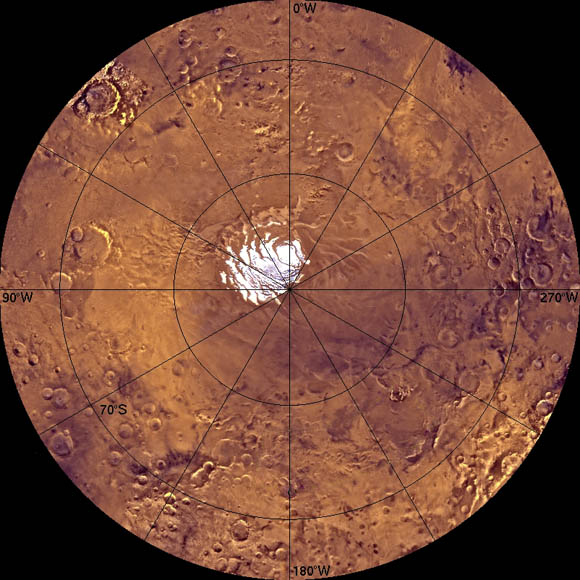
There is something very unexpected about where this is located.
5. Where is Mars' south polar cap? See if you can estimate how many kilometers it is from the pole using this map. Each circle around the pole is 10 degrees in latitude. There are 360 degrees all the way around Mars circumference, and Mars has a diameter of 6800 km.
It is the unique local landscape that determines the wind patterns that create the offset of the deposits for the true pole of the planet.
Radar measurements of the water ice at the south pole taken with a spacecraft jointly operated by the European Space Agency and NASA indicated that it is nearly pure frozen water ice underneath, and that there is enough water to cover the planet in a layer about 10 meters (30 feet) deep if it were liquid. Mars north polar cap is also a reservoir of water ice.
Mars climate depends dramatically on its polar caps because so much dry ice can solidify that the pressure in the atmosphere will drop when a polar cap grows. Global dust storms arise in the spring and fall when the dry ice "sublimes", and turns to gas. Wikipedia has an an interesting article on Mars climate if you want to learn more.
Olympus Mons
Before we look at the exciting recent discoveries, let's tour two prominent features seen when the Mariner spacecraft visited Mars in the early 1970's.
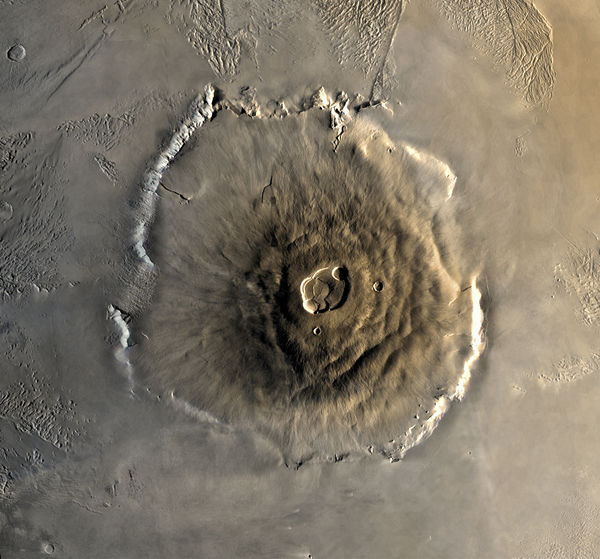
Olympus Mons is the largest volcano on Mars, and apparently also the largest in the entire solar system. It rises to more than three times the height of Mt. Everest on Earth, and would cover the entire volcanic Hawaiian Island chain. You can clearly identify the central "caldera", where the volcanic activity would have released lava and gas. Crater counts indicate that some regions of the shield are no more than a few million years old. There is no sign of current activity, however.
The diameter of the caldera (the central crater) is about 65 km, roughly the size of Louisville, Kentucky. Measure the diameter of the caldera in millimeters as it shows on your screen, and the diameter of the shield – the region out to the cliffs toward the edges of the picture. Use the ratio of these diameters and the scale of 65 km for the caldera to estimate the overall size of the base of this shield volcano.
6. About how large in kilometers is the base of the shield volcano?
Now look at either maps.google.com/mars or use Google Earth software showing the globe of Earth.
7. What state in the US or country in Europe has about the same overall size as the base of Olympus Mons?
As one parting question about Mars' volcanoes, use www.google.mars or Google Earth (selecting Mars) and locate Olympus Mons in their interactive maps and images. It is very distinctive and easy to find, not far from the equator of Mars. There are indices and search boxes both in the web-based Mars map and in the 3D Google Earth version.
8. There are other shield volcanoes on Mars. How many can you find and identify? On Earth, such volcanoes often are over a plume of molten core material and appear in a series of volcanic mountains as a floating tectonic plate moves over the hotspot of molten material. The Hawaiian Islands are an example.
Valles Marineris
A large chasm called Valles Marineris crosses the midsection of Mars. To gain a real sense of its enormous extent find in Google Earth, or on the www.google.com/mars website.
9. How long is Valles Marineris in kilometers? Compare this to the Grand Canyon on Earth, which is about 400 km long.
Something New
NASA currently has several missions recently operating on Mars. Three to consider are
* Mars Reconnaissance Orbiter * Mars Exploration Rovers * Curiosity - Mars Science Laboratory
Reconnaissance Orbiter is returning images and other scientific measurements from orbit. The Exploration Rover Spirit reported from the surface for 6 years, from 2004 to 2010. The Opportunity Rover from the same mission is still active.
Mars Science Laboratory launched in November 2011 and arrived at Mars in August 2012. It placed the Curiosity Rover in Gale crater to look for conditions and evidence for microbial life.

Google Earth on the lab computers or your laptop will link an interactive globe to the latest data. Otherwise you may use the NASA websites along with www.google.com/mars and the sidebar indices to explore the latest discoveries.
10. Where is Gale Crater on Mars? Identify it with respect to larger features.
This part of the lab is open ended, and we will leave it to you to find something of interest now that you have the basics down. If you're lost in all the possibilities, try following the path of the Odyssey Rover from its starting point to its current location. Google Earth offers interactive access to panoramic views and links to data acquired and discussions along the way. Here's are links to a short video produced in 2009 describing the rover landings, and another video summarizing the science.
Recent measurements from all the spacecraft are raising confidence that there is currently a lot of frozen water on Mars. Peter Smith, who led the Mars Phoenix team to the successful landing near the north pole describes their work in this mp3 podcast.
11. Find something of interest to you that is "recent", from one of the NASA or ESA missions within the last two years, or last two weeks! Describe what you found, and your interpretation of its importance relative to our understanding of Mars.